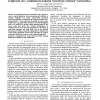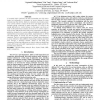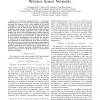636 search results - page 44 / 128 » High-efficiency power amplifier for wireless sensor networks |
ICC
2007
IEEE
14 years 3 months ago
2007
IEEE
In contention-based sensor networks, nodes compete to access a shared channel for data transmission and collision is a common challenge. For power conservation, periodical active/s...
TMC
2008
13 years 8 months ago
2008
In multihop wireless sensor networks that are often characterized by many-to-one (convergecast) traffic patterns, problems related to energy imbalance among sensors often appear. S...
ITNG
2007
IEEE
14 years 3 months ago
2007
IEEE
In wireless sensor networks, the data transmitted from the sensor nodes are vulnerable to corruption by errors induced by noisy channels and other factors. Hence it is necessary t...
MOBICOM
2004
ACM
14 years 2 months ago
2004
ACM
Target tracking is an important application of wireless sensor networks. In this application, the sensor nodes collectively monitor and track the movement of an event or target ob...
GLOBECOM
2006
IEEE
14 years 2 months ago
2006
IEEE
— The path loss exponent (PLE) is a parameter indicating the rate at which the received signal strength (RSS) decreases with distance, and its value depends on the specific prop...



